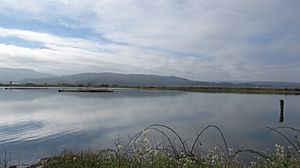Arcata Wastewater Treatment Plant and Wildlife Sanctuary facts for kids
Arcata Wastewater Treatment Plant and Wildlife Sanctuary is a super cool and smart way the city of Arcata, California cleans its water. It's not just a place for treating sewage; it's also a home for lots of amazing wildlife!
This special place uses a series of ponds, treatment wetlands, and marshes to clean dirty water. These marshes also act as a safe haven for animals, especially birds, because they are right on the Pacific Flyway. This means many birds stop here during their long journeys. The Arcata Marsh is a very popular spot for people who love to watch birds. It even won an award for being so innovative! Many of the ponds, called "lakes," are named after people who helped create this awesome project, like professors George Allen and Robert A. Gearheart from Cal Poly Humboldt. Even though it's a place where sewage is treated, these open-air lakes don't smell bad at all! People love to visit for birdwatching, cycling, and jogging.
Contents
How Arcata Cleans Its Water
Cleaning dirty water, called sewage treatment, happens in several important steps here:
- Step 1: Primary Treatment (started in 1949): First, the dirty water sits in big tanks. Heavier bits, called sludge, sink to the bottom and are removed. This sludge can even be used as fertilizer!
- Step 2: Secondary Treatment (started in 1957): The water then moves to large ponds. Here, tiny helpers called bacteria get to work, breaking down most of the remaining waste.
- Step 3: First Disinfection (started in 1966): After the ponds, the water is treated with chlorine to kill any harmful germs, called pathogens. Then, the chlorine is removed so it doesn't hurt nature.
- Step 4: Tertiary Treatment (started in 1986): The water flows into special man-made marshes. Plants like reeds and cattails, along with more bacteria, give the water a final scrub, making it even cleaner.
- Step 5: Second Disinfection: Because birds live in the marshes, their droppings can add new germs. So, the water is chlorinated one more time to kill these germs, and then the chlorine is removed again before the water goes back into the bay.
Wetlands and Marshes: Nature's Filters
The Arcata system uses two main types of natural filters: treatment wetlands and enhancement marshes.
- Treatment wetlands are like the first natural cleaning stage. They help make the water clean enough to meet important government standards.
- Enhancement marshes are the final cleaning stage. They make the water even purer and also create wonderful homes for wildlife.
After the water leaves the treatment wetlands, it's disinfected. Then, it can either go straight into Humboldt Bay or flow through the enhancement marshes for extra cleaning. The water from the enhancement marshes is disinfected again because birds living there can add bacteria. This whole process makes sure the water is safe for the bay and its creatures.
Nature's Cleaning Power
Wetland plants are amazing! They use sunlight to grow a lot of plant material, much more than a wheat field. When these plants break down, they create a rich food source, called detritus, for tiny creatures, birds, and mammals. This means the wetlands not only clean water but also support a whole food chain.
The City of Arcata cleans about 2.3 million gallons (about 8,700 cubic meters) of water every day. When it rains a lot in winter, this amount can go up to 16.5 million gallons (about 62,000 cubic meters) daily! Scientists at Cal Poly Humboldt are always studying the marsh to make sure it's safe for all the wildlife and the bay. They want to be sure that the cleaning process doesn't accidentally harm any animals.
Amazing Wildlife at the Marsh
The Arcata Marsh and Wildlife Sanctuary is a huge area, covering 307 acres. It's a vital stop along the Pacific Flyway, a major route for migrating birds. More than 327 different kinds of birds have been seen here!
But it's not just birds. The marsh is home to many other creatures too, including:
- River otters
- Gray foxes
- Red-legged frogs
- Tidewater goby fish
- Bobcats
- Striped skunks
- Praying mantises
- Red-sided garter snakes
It's a bustling ecosystem full of life!
Learn More at the Interpretive Center
The Friends of the Arcata Marsh (FOAM) run the Arcata Marsh Interpretive Center. This is a great place to visit and learn all about how the treatment plant works, why the marsh is so important, and meet the plants and animals that live there. Friendly volunteers give tours of the marsh, and there are special programs for schools, scout groups, and even summer camps!


